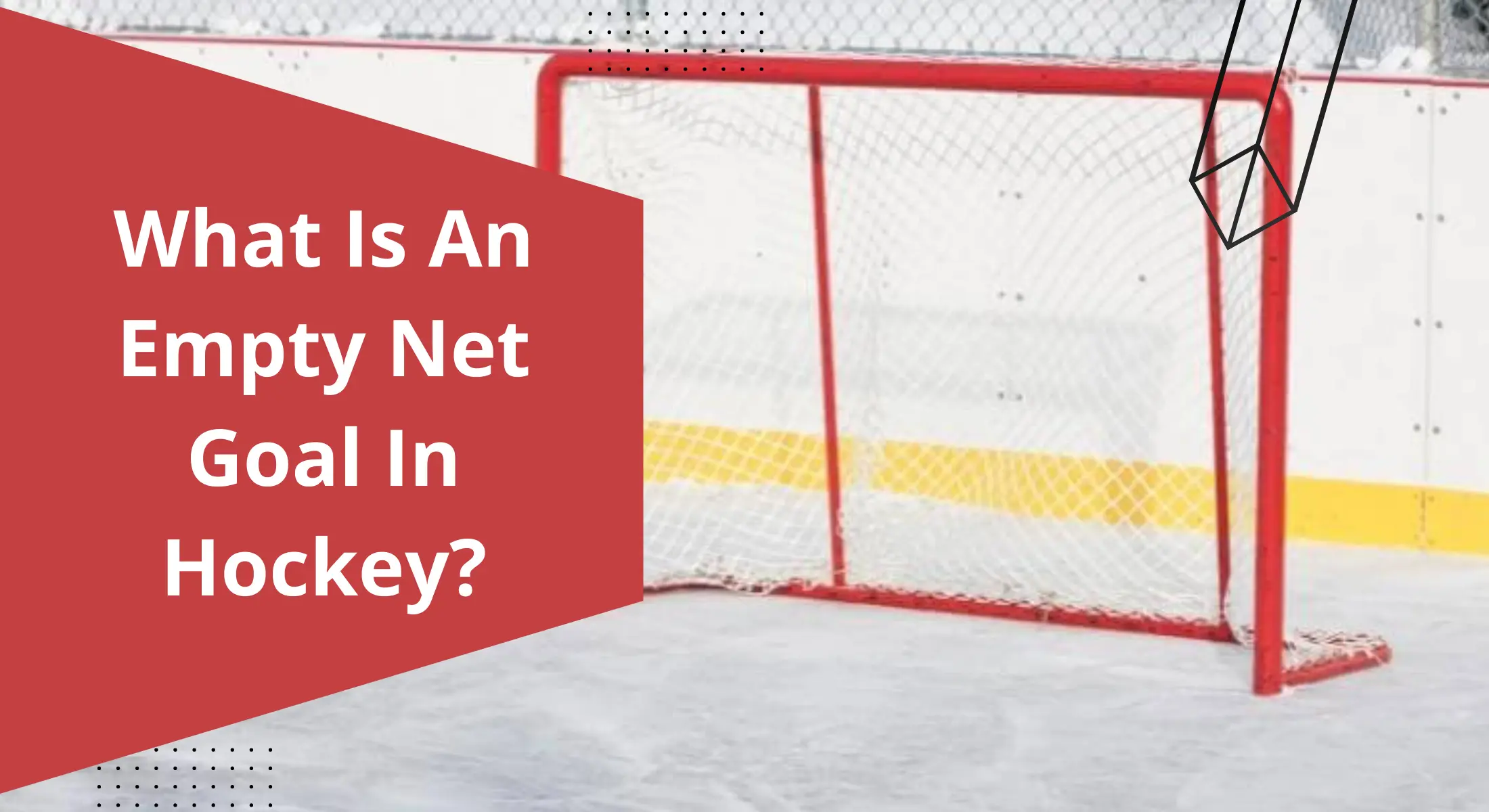At the near end of a hockey game, you would have seen that if the goal is between 2 minutes or even less, the area of the net is quite empty. But why? Why is the net empty and what does it really mean to score on an empty net? Let us see:
The empty net is a strategy employed by many hockey teams. It is a way to increase the probability of scoring by decreasing the number of goals against. A team can remove its goalie from the net to put an extra attacker on the ice to try to score, only for their opponent to score while the goalie is out. In other words, empty-net goals occur when a goalie is taken off the field, allowing the opposing team to score.
The term “empty net” is sometimes used interchangeably with “closing time,” but there are some differences between these two terms. Closing time is when all players have left the ice and removed their equipment or a team has finished playing overtime. After this point, coaches will usually begin leaving their benches and entering the locker rooms.
Why is the net empty?
The net is empty in hockey because of several factors, including the size and shape of the goal, the type of surface being used to play the game, and more.

Additionally, the fact that hockey pucks are made from rubber makes them extremely difficult to put into motion without striking another object before they reach their destination. This makes scoring goals extremely difficult when playing on a hard surface like asphalt or concrete where there are no obstructions for pucks that have been shot directly into an open space.
Pulling the goalie
Pulling the goalie is a strategy used in ice hockey where the team’s goaltender is replaced by an extra attacker during a critical situation, usually when the team is trailing by one or two goals in the game’s closing minutes. By pulling the goalie, the team gains an additional skater on the ice, which increases their offensive potential, but leaves the net empty and vulnerable to the opposition’s scoring attempts.
This strategy is considered a high-risk, high-reward approach that can either lead to a dramatic comeback victory or a disastrous loss. Pulling the goalie requires careful consideration of the game situation, the opposing team’s strengths and weaknesses, and the timing of the decision. It is a common tactic used in professional ice hockey and often creates exciting and unpredictable moments for both players and fans.
Related Post: How do Line changes work in ice Hockey?
Delayed penalty
A delayed penalty empty-net goal is scored after a player has been penalized but before the ensuing faceoff. In this case, the player who was originally on the ice for the infraction receives a delay of game penalty (one minute for each player on the ice at the time).
The NHL has always allowed delayed penalties to be awarded in instances where an attacking player trips or collides with an opposing player and causes him to fall out of position. The team that caused the action to occur can now score on their opponent while they are down. This is also known as “hockey death”.
Empty net goals on the scoresheet
The NHL scoresheet shows a team’s goals and assists, as well as the number of empty-net goals they have scored. Empty net goals are scored when a player shoots the puck into the empty net after their team has already scored more than one goal.

Furthermore, an empty-net goal is worth one point under most scoring systems, but some leagues award two points (such as the Russian Kontinental Hockey League) and others award none at all (such as the National Hockey League).
Do empty net goals count against plus-minus?
Yes, empty net goals count toward plus-minus statistics in ice hockey. When a team scores an empty net goal, it means that the opposing team has pulled their goaltender in an attempt to score and tie the game, which leaves their net unguarded.
If a player on the team that is leading scores a goal into the empty net, they will receive a plus-one in their plus-minus statistic, and the opposing team’s players on the ice at the time will receive a minus-one in their plus-minus statistic.
Who has scored the most career empty net goals?
The player who has scored the most career empty-net goals in the National Hockey League (NHL) is Wayne Gretzky. He scored a total of 56 empty net goals during his career. Gretzky is widely regarded as one of the greatest ice hockey players of all time and holds numerous NHL records, including the most career goals, assists, and points.
| Players | Career Empty Net Goals |
| Wayne Gretzky | 56 |
| Alex Ovechkin | 54 |
| Marian Hossa | 40 |
| Eric Staal | 33 |
| Mario Lemieux | 33 |
| Brad Marchand | 32 |
Related Post: Why do hockey players get kicked out of faceoffs?
Most famous empty net goal ever!
In the history of the National Hockey League, there is only one empty-net goal that has been rated as the most famous goal ever.
- On March 20, 2001, during a game between the Dallas Stars and the Edmonton Oilers, Stars forward Mike Modano scored an empty-net goal for his team’s fifth and final victory of the season. The goal was so memorable that it was featured in ESPN’s 30 for 30 documentary “Endless Game” and was used as an example of a “dumb play” by Wayne Gretzky.
- The goal was also voted as one of the top 100 NHL moments in a poll conducted by TSN’s “Fury”, which asked fans to vote on their favorite hockey moments from all time.
How to Prevent Empty Net Goals in Hockey?
Empty net goals can be a devastating blow to a hockey team, as they often seal the victory for the opposing team. However, there are several strategies that can be used to prevent empty net goals and keep the game within reach:
- Maintain puck possession: When a team has the puck, the opposing team cannot score. Therefore, it is crucial to maintain possession of the puck in the offensive zone and avoid turnovers that could lead to an empty net goal.
- Use a defensive forward: Teams can deploy a defensive forward to shadow the opposing team’s top offensive player and prevent them from getting a breakaway opportunity toward the empty net.
- Positioning: Players on the ice should be aware of their positioning and ensure that at least one player is covering the empty net. This can prevent easy goals from long-range shots.
- Dump and chase: If the team is unable to maintain possession of the puck in the offensive zone, they can opt to dump the puck into the opposing team’s zone and chase after it. This can prevent the opposing team from easily gaining possession of the puck and scoring on the empty net.
- Communication: Players on the ice should communicate with each other to ensure they are aware of the situation and can make decisions accordingly. This includes calling for passes, positioning, and making sure someone is covering the empty net.
Preventing empty net goals requires a combination of defensive strategies and communication on the ice. With these strategies in place, a team can minimize the risk of losing a game due to an empty net goal.
Frequently Asked Questions
Why is an Empty Net Important?
What are Some Ways to Score an Empty Net Goal?
Can an empty net goal be scored shorthanded?
Can a team score multiple empty-net goals in a single game?
Are empty net goals considered a cheap way to score?
Conclusion: What is an empty net goal in hockey?
In conclusion, the empty net is a great way to score in hockey. The team that scores first is always able to get an advantage over the other team because they can take advantage of their opponent’s mistakes and snatch up some goals. The goalie must make sure that he stays focused and ready to make a save, while also keeping track of his teammates’ movements on the ice.
An empty net is when there are no players on either team still in the zone. It is usually part of the endgame, but it can also be used to celebrate a goal by either team.


